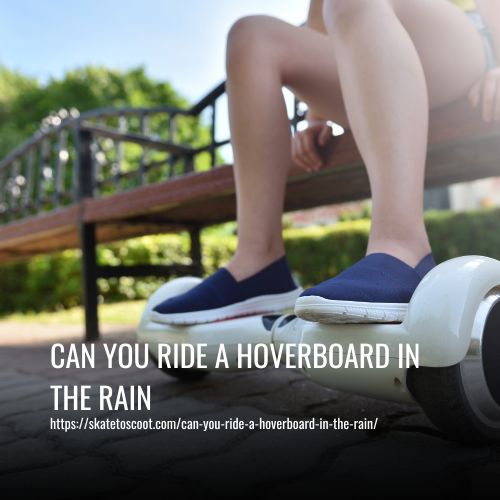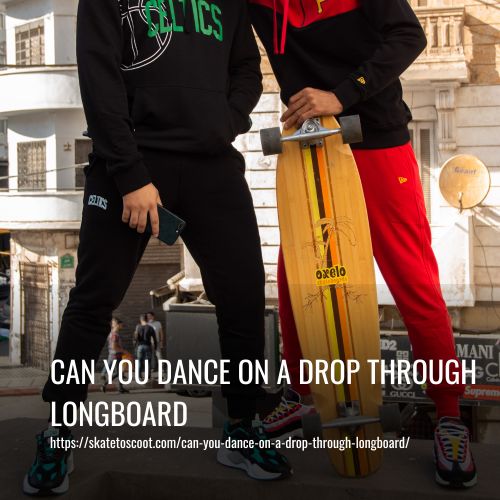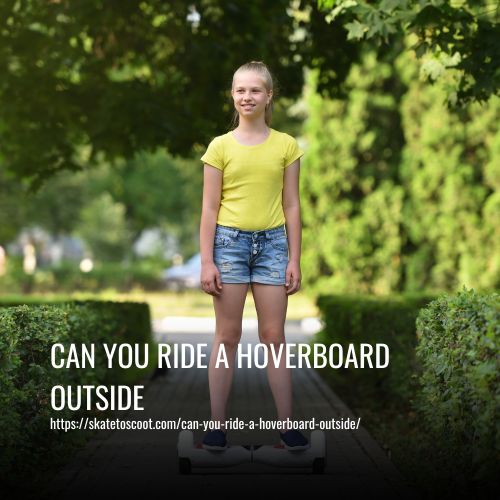As an Amazon Associate we earn from qualifying purchases.
No, you cannot ride a hoverboard in the rain. Hoverboards are not waterproof and can be easily damaged by water. The electronic components inside the hoverboard, such as the motherboard, batteries, wheel motors, and sensors, are not designed to withstand contact with water.
If water gets into these components, it can cause malfunctions or even permanent damage to the hoverboard. It is important to follow the manufacturer’s guidelines and avoid using the hoverboard in wet conditions. Waiting for the rain to stop and for the surface to dry before using the hoverboard again is the best course of action to ensure your safety and prevent damage to the hoverboard.

Why Not Ride a Hoverboard In The Rain?
The hoverboard is not recommended to ride in the rain due to the risk of water damage. Rainwater can easily penetrate the plastic casing of the hoverboard, exposing its delicate electronic components such as the motherboard, sensors, and switches. As we all know, water and electronics are not a good combination, as even a small amount of moisture can cause irreversible damage to the internal components.
Therefore, it is highly advisable to keep your expensive hoverboard away from rain or any contact with water to ensure its longevity and performance. By following this precautionary measure, you can enjoy riding your hoverboard safely and without the need for costly repairs or replacements.
Is It Safe To Ride A Hoverboard In The Rain?
Riding a hoverboard in the rain can be risky and potentially unsafe. Wet surfaces increase the likelihood of slipping and falling, posing a safety hazard. Moreover, electronic devices like hoverboards are not designed to withstand contact with water, and water can damage their internal components.
Before riding a hoverboard in the rain, it is crucial to refer to the manufacturer’s guidelines and follow their recommended usage instructions. It is also advisable to take necessary precautions like wearing non-slip shoes and protective clothing.
When riding on wet surfaces, it is essential to exercise extra caution, maintain a slower speed, and be mindful of reduced visibility. By prioritizing safety and following the appropriate guidelines, potential accidents and damage to the hoverboard can be minimized.
Is the Hoverboard Waterproof?
While the latest models boast impressive capabilities, one area where they still fall short is waterproofing. Hoverboards are not designed to be fully waterproof, although some manufacturers offer water-resistant options that can withstand inclement weather conditions. However, it is important to note that these hoverboards are not intended for use in the rain or in puddles.
Just like you wouldn’t submerge a water-resistant smartphone in a pool or use it in the rain, it is not advisable to expose a water-resistant hoverboard to water. Despite their water-resistant features, hoverboards are not immune to water damage. Therefore, it is essential to avoid riding them in rainy conditions or on wet surfaces to prevent potential damage to the electronic components and batteries.
Tips for Riding a Hoverboard in the Rain:
If you decide to ride your hoverboard in the rain, there are a few tips to keep in mind for a safe experience. First, it is advisable to use a waterproof cover to protect the electronic components from water damage. Additionally, riding at a slower speed can help maintain better control on wet surfaces.
It is important to avoid riding over puddles as they can be slippery and dangerous. Lastly, wearing appropriate gear, such as a raincoat and non-slip shoes, can help ensure your safety while riding in the rain.
Remember to take precautionary measures to protect your hoverboard from water damage and to maintain a smooth and safe ride in wet conditions.
Potential Hazards of Riding in the Rain:
While hoverboards have become a popular mode of transportation, it is important to understand their limitations, especially when it comes to riding in the rain. Hoverboards are not designed to be waterproof or water-resistant, and exposing them to wet conditions can cause serious damage to their electronic components. In this article, we will explore the potential hazards of riding a hoverboard in the rain and provide some important tips to help keep your hoverboard safe and functioning properly.
- Water Damage to Electronic Components: Hoverboards consist of sensitive electrical components that are prone to damage when they come into contact with water. The electronic circuitry and lithium-ion battery can malfunction or short-circuit if exposed to moisture. This can lead to a complete breakdown of the hoverboard’s functionality and potentially pose a safety risk to the rider.
- Reduced Traction on Wet Surfaces: Riding a hoverboard on wet surfaces poses a significant risk due to reduced traction. The tires of standard hoverboards are not designed to provide adequate grip on wet or slippery terrain, increasing the chances of accidents and falls. The lack of traction can make it challenging to control the hoverboard, potentially resulting in injuries.
- Increased Risk of Accident: Wet conditions, such as heavy rain or deep puddles, can make riding a hoverboard more challenging and dangerous. The ingress of water into the hoverboard’s internal components can disrupt the flow of electrons and cause the hoverboard to malfunction unexpectedly. This can lead to loss of control, sudden stops, or even the complete shutdown of the hoverboard, putting the rider at risk of accidents or injuries.
- Costly Repairs: Exposing a hoverboard to rain or other wet conditions can result in costly repairs. Repair centers often charge a premium for fixing water-damaged hoverboards, as delicate components may need to be replaced entirely. Additionally, the repair process can be time-consuming, leaving you without a hoverboard for a significant period.
How does riding in the rain affect the battery life of a hoverboard?
Riding a hoverboard in the rain can have a negative impact on the battery life of the device. The electronic components of a hoverboard are not designed to be exposed to water or wet conditions. Water can seep into the internal components, causing damage to the electrical circuitry and the lithium-ion battery.
When water enters the hoverboard, it can disrupt the flow of electrons and potentially short-circuit the device. In some cases, water damage can be irreversible and costly to repair. To protect your hoverboard from water damage, it is recommended to avoid riding it in rainy conditions, deep puddles, or on wet surfaces. It is also important to store your hoverboard in a dry place and keep it away from direct contact with water.
In case the hoverboard gets wet, it is advisable to immediately dry it with a soft cloth and remove any water that may have entered the device. However, it is important to note that even with water-resistant features, hoverboards are not completely waterproof, and riding in wet conditions can still pose a risk to the device’s battery life.
Are there extra maintenance needs for a rain-ridden hoverboard?
A hoverboard that has been ridden in the rain may require additional maintenance to ensure its longevity and proper functioning. When a hoverboard comes into contact with water, it is important to clean and dry it thoroughly after each use. This will help prevent any water damage from occurring to the electronic components of the hoverboard. It is also crucial to check the battery and electrical components to ensure that they are still working properly.
Following any additional guidelines or instructions provided by the manufacturer specifically for using and maintaining the hoverboard in rainy conditions is also essential. By taking these extra maintenance steps, riders can help prevent costly repairs and ensure a smooth and enjoyable ride on their hoverboard, even in wet conditions.
What to do When the Hoverboard Gets Wet?
If your hoverboard gets wet, whether due to rain or accidental contact with water, it is important to take immediate action to prevent any potential damage. Here are the steps to follow when faced with a wet hoverboard:
- Soak up the water: Start by using a dry cloth to soak up any water on the surface of the hoverboard. This will help prevent the water from seeping further into the device.
- Check the charging port: Inspect the charging port for any signs of moisture. If you find it wet, use a tissue or expose it to sunlight to dry it out.
- Examine for damp spots: Look closely for any damp spots on the hoverboard. Wet spots indicate that water may have penetrated the internal components, which could potentially cause damage.
- Test the hoverboard: Allow the hoverboard to dry for a few hours and then attempt to turn it on. This will help determine if any water has affected its functionality.
- Remove the motherboard: If water has entered the casing, carefully unscrew the plastic casing and unplug everything before removing the electronic motherboard.
- Inspect the motherboard: Check the motherboard for any signs of water damage. If present, gently blot the water with a cloth or napkin.
- Use rice to absorb moisture: Place the dry motherboard in a bowl of uncooked rice. The rice acts as a moisture absorber and can help remove any remaining moisture from the device.
- Wait for 48-72 hours: Allow the motherboard to remain in the rice for at least 48-72 hours. This will ensure that all moisture is completely absorbed.
- Reassemble and test: Once the motherboard is dry, reassemble the hoverboard and reconnect all the components. Switch it on to check if it is functioning properly.
If these steps do not solve the issue, it is recommended to seek professional help from a repair center. They can assess the extent of the damage and perform any necessary repairs to get your hoverboard back in working condition. Remember, immediate action is crucial to prevent further damage and costly repairs.
FAQs
Riding a hoverboard in the rain is not recommended. Hoverboards are not designed to be water-resistant and exposing them to wet conditions can potentially damage the electronic components. It is best to avoid riding on wet surfaces to ensure the longevity of your hoverboard.
Yes, you can ride certain hoverboard models on grass. However, not all hoverboards are suitable for this type of terrain. Models with larger tires and off-road capabilities are better equipped to handle unpaved surfaces like grass.
To clean your hoverboard, it is important to use a soft cloth and avoid submerging it in water. Simply wipe the surface and any dirt or debris with a dry cloth. Do not use any harsh cleaning agents as they can damage the hoverboard’s outer casing.
No, you should never submerge your hoverboard in water. Hoverboards are not designed to be waterproof and exposing them to water can cause significant damage to the electrical components. It is important to take precautions and avoid any direct contact with water.
It is important to avoid using the hoverboard on wet surfaces, even if they are only slightly damp, as the hoverboard is not waterproof or water-resistant and can sustain heavy damage if water enters it.
Conclusion:
While riding a hoverboard in the rain may seem like a thrilling idea, it’s important to consider the risks involved. Not only can water damage the electrical components of the hoverboard, but it can also make the surface slippery and increase the chances of accidents. So, if you want to keep your hoverboard in top condition and ensure your safety, it’s best to save the rain for another day and enjoy the ride on dry ground. Stay safe and keep on gliding!
Amazon and the Amazon logo are trademarks of Amazon.com, Inc, or its affiliates.



